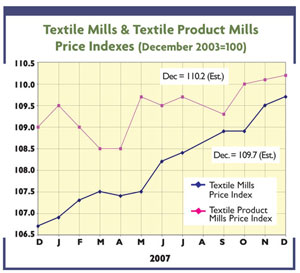After the overall pessimistic messages of the last few weeks and months, this is good news: The
Rieter Group recorded record sales and orders received in 2007. The order volume rose to CHF
4,066.4 million (US$3,698 million), which is a 7-percent plus compared to the previous year. Also,
sales rose to a new all-time high of CHF 3,930.1 million (US$3,574.3 million), this is 12-percent
higher than 2006. The performance is solely based on organic growth in both divisions. Exchange
rate movements had a slightly positive impact too on the group sales. Based on the trend in
operating results at the Textile Systems Division, Rieter expects an improvement in the operating
result and a further increase in net profit and earnings per share for 2007.
Rieter says the global economy developed positively in 2007. Growth was a characteristic
feature in all major industrialized countries as well as in the emerging markets in Asia and Latin
America. Both divisions of the Rieter Group — Textile Systems and Automotive Systems — recorded
significant growth.
Textile Systems
For textile machinery producers, the investment climate on the world market was generally
favorable in 2007. The strongest demand for spinning machinery came from Turkey and from the Asian
countries India and China. Demand was especially strong in the first six months. According to
Rieter, major reasons for this success are a systematic renewal of the product offering, an
efficient global sales and service organization, and increasing value-added in India and China.
Compared with 2006, orders received were 6-percent higher, reaching a record level of CHF
1,703.1 million (US$1,548.8 million), compared with CHF 1,614.3 million (US$1,468.1 million) in
2006. Demand declined in the second half of the year. However, the intake of CHF 619 million
(US$563 million) still exceeded the average six-month figure for the years 2004 to 2006. Sales
increased by 18 percent to the historic record level of CHF 1,566.8 million (US$1,424.9 million).
Sales revenues lost as a result of the divestiture of the man-made fiber machinery business at the
end of 2006 were more than offset. By orders received, Turkey, India and China also headed the
sales rankings: Including Turkey, the division generated 71 percent of sales in Asia in the year
under review, compared with 67 percent in 2006.
All product segments contributed to the high order intake, spinning machinery as well as
technology components. Furthermore, Rieter secured large orders in the United States and Brazil,
where rotor spinning lines are traditionally in use.
The growing importance of the nonwovens sector is also reflected in the Rieter results: the
company received more orders for nonwovens production and pelletizing machinery than ever before.
Automotive Systems
Vehicle output increased worldwide. The production in 2007 rose by 5.3 percent to 69.6
million vehicles. Trends diverged in Rieter Automotive Systems’ two main markets, Western Europe
and North America. While vehicle production declined slightly in North America, it increased by 2.4
percent in Western Europe. The countries in Eastern Europe, Asia and Latin America recorded
significantly stronger growth in production.
Rieter Automotive Systems grew faster than vehicle production, especially in Western Europe
and North America. The division also posted a substantial increase in sales in South America.
Business with the Japanese manufacturers developed positively, especially in the United States.
Rieter Automotive Systems received major new orders for carpet systems in the United States and
deliveries started for various new car models. Therefore, Rieter is expecting further sustained
growth.
The division’s sales of CHF 2,363.3 million (US$2,149 million) were 8-percent higher. Growth
was just as strong in the second half as in the first six months of 2007. According to Rieter
comments, this organic growth was due to its “leading position as a supplier of acoustic and
thermal management systems. Rieter Automotive continued to support the automotive manufacturers’
goals of weight and CO2 reduction in 2007 with its weight-saving acoustic packages and aerodynamic
underfloor modules.”
More positive news is welcome. Please send to
jrupp@textileworld.com.
February 5, 2008





